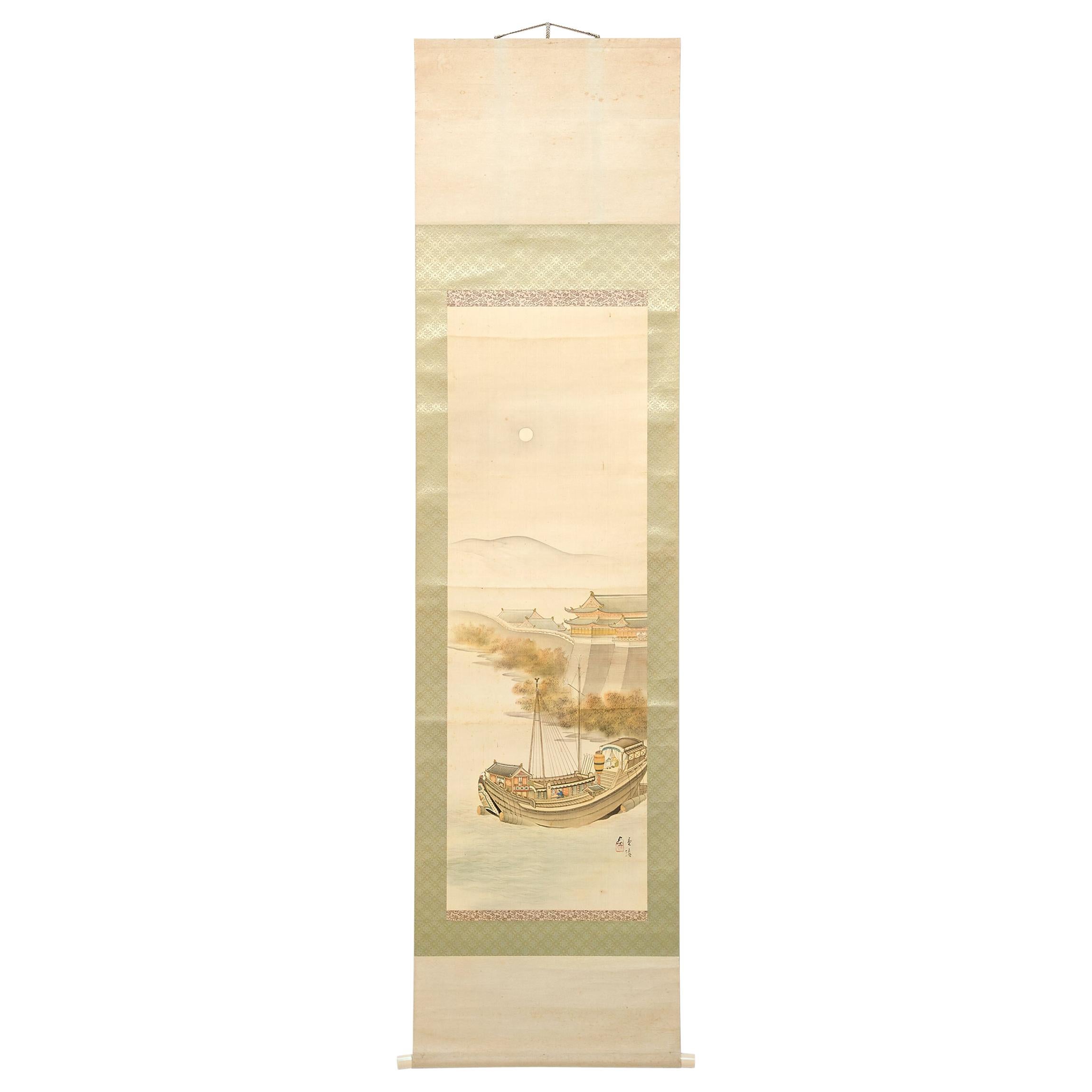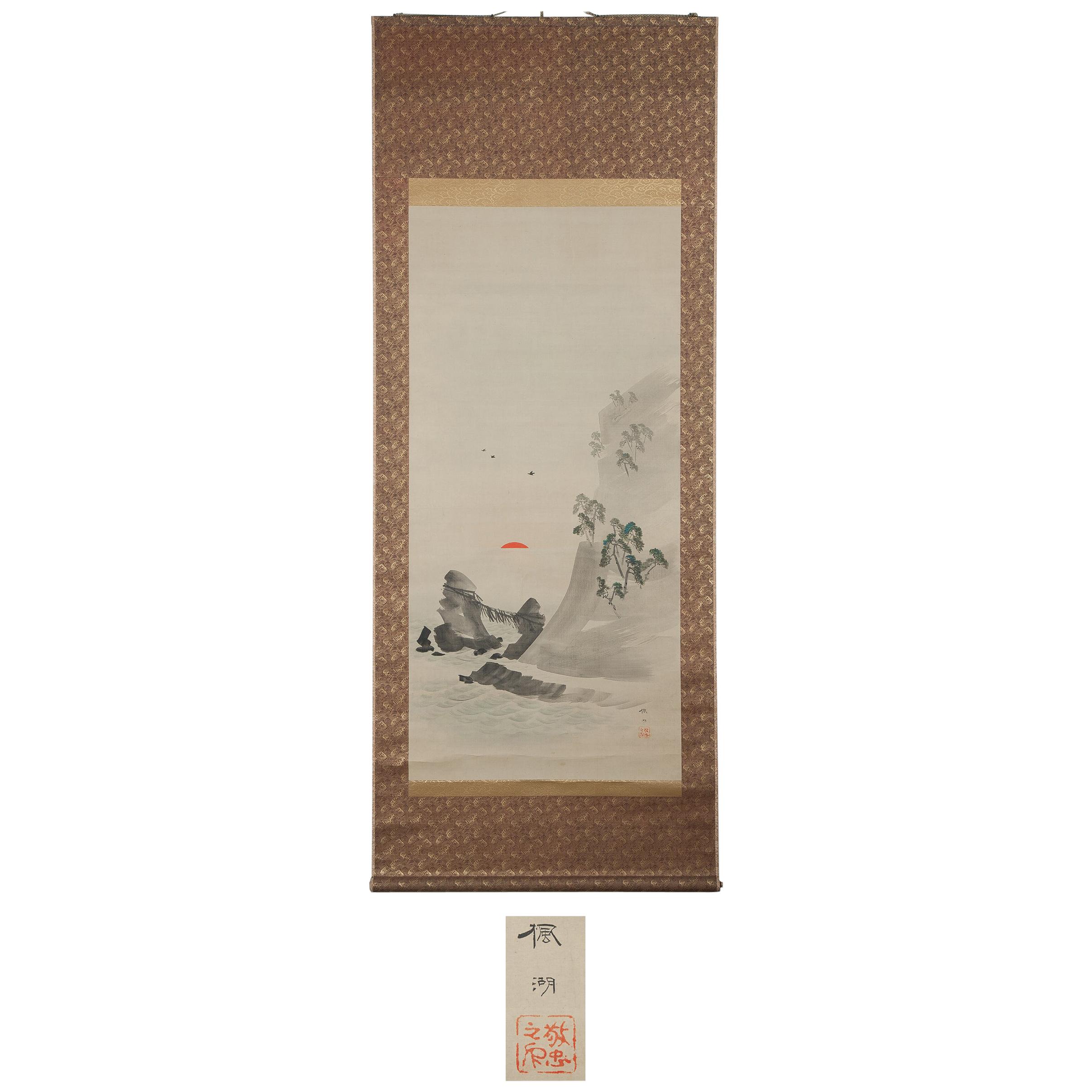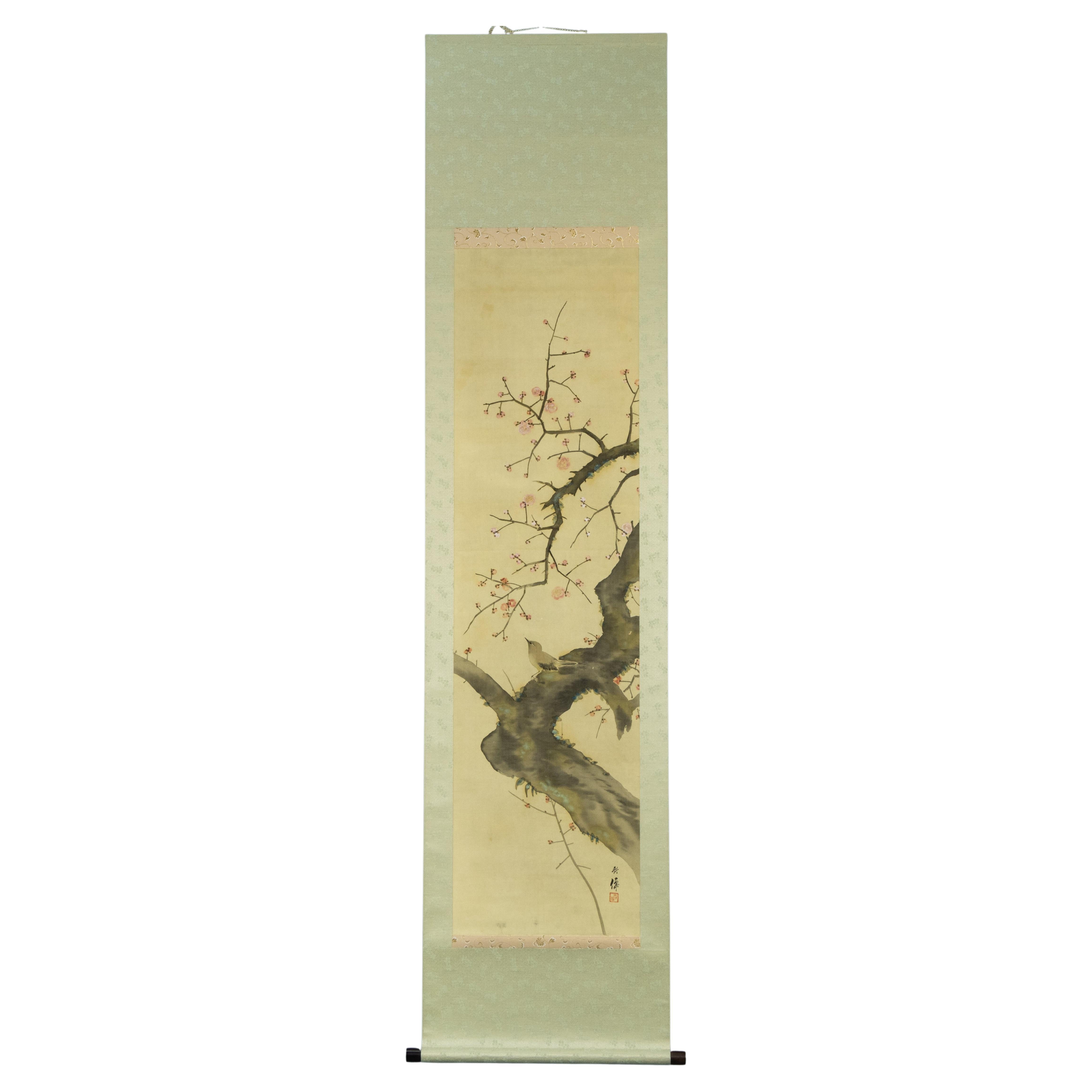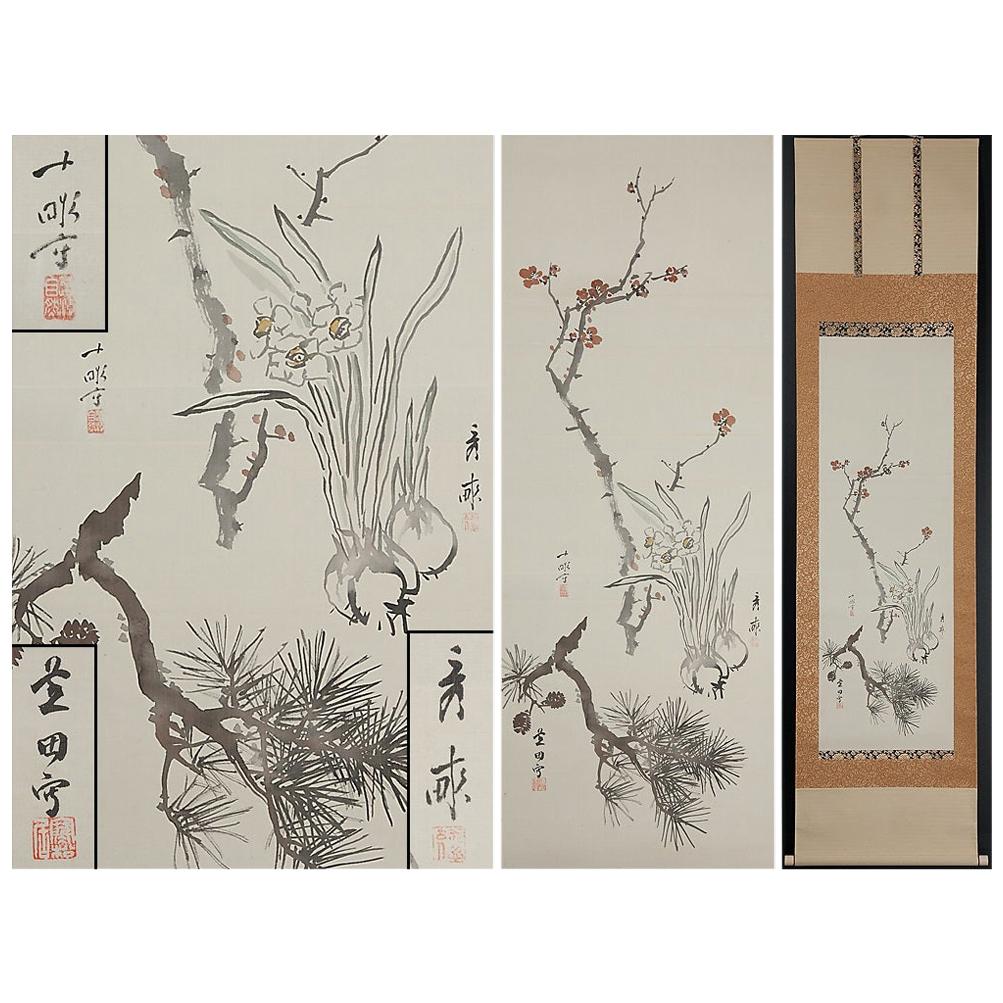Items Similar to Japanese Meiji Hanging Scroll of Ayu Fish, c. 1850
Want more images or videos?
Request additional images or videos from the seller
1 of 6
Japanese Meiji Hanging Scroll of Ayu Fish, c. 1850
About the Item
Although Western painting was initially embraced during Japan’s Meiji period (1868–1912), artists brought on a revival of traditional painting styles as they sought to create a modern Japanese style with roots in the past. This decorative hanging scroll honors traditional calligraphy painting with delicate detail and a refined composition, thought to inspire clear and concise thinking. The serene setting depicts a school of silvery ayu, or sweetfish, swimming in a calm body of water beneath a flowering cliffside. A misty horizon is conveyed with a wash of soft blue color and the motion of the current through fluid brushstrokes that outline each wave.
A prized delicacy of Japanese cuisine, ayu is known as a symbol of summer. Like the koi fish, the ayu is a common motif in Japanese art as it’s a fish that’s known to swim upstream, battling rushing currents, rapids and waterfalls. This symbol of perseverance is often associated with children in hopes for their growth and development. Painted on woven silk, the quiet scene is finished with the artist’s mark and set against a blue silk brocade border patterned with blossoms and trailing vines.
- Dimensions:Height: 75 in (190.5 cm)Width: 27.5 in (69.85 cm)Depth: 1 in (2.54 cm)
- Style:Meiji (Of the Period)
- Materials and Techniques:
- Place of Origin:
- Period:
- Date of Manufacture:c. 1850
- Condition:Wear consistent with age and use.
- Seller Location:Chicago, IL
- Reference Number:

About the Seller
4.9
PAGODA RED is a renowned resource for designers as well as collectors of contemporary and ancient Chinese, Korean and Japanese art. They offer a curated edit of fine and provincial furniture, ceramics, scholars' objects, and paintings and textiles, each piece historically and geographically authentic.
Diamond Seller
These expertly vetted sellers are 1stDibs' most experienced sellers and are rated highest by our customers.
Established in 1997
1stDibs seller since 2006
1,416 sales on 1stDibs
Typical response time: 1 hour
- ShippingRetrieving quote...Ships From: Chicago, IL
- Return PolicyA return for this item may be initiated within 2 days of delivery.
More From This SellerView All
- Japanese Meiji Riverside Scroll Painting, c. 1900Located in Chicago, ILAlthough western painting was initially embraced during Japan’s Meiji period (1868-1912), artists brought on a revival of traditional painting styles as they sought to create a modern Japanese style with roots in the past. This exquisite hanging scroll demonstrates the preference for soft layering of gray tones with judicious use of color. The landscape is rendered in soft ink washes that subtly distinguish between water, mountain, and sky. The scroll painting...Category
Early 20th Century Japanese Meiji Paintings and Screens
MaterialsPaper
- Chinese Hanging Scroll of Prunus Branches, circa 1850Located in Chicago, ILChinese scholars used natural imagery and scenery to aid in contemplation within the walls of their studios. The complex beauty inherent to landscapes and natural forms inspired clea...Category
Antique Mid-19th Century Chinese Qing Paintings and Screens
MaterialsPaper
- Monumental Chinese Ancestor Portrait Scroll, c. 1850Located in Chicago, ILBelieving that the departed continue to hold influence over the lives of the living, many Chinese households honor their ancestors in private family rituals, invoking their spirits f...Category
Antique Mid-19th Century Chinese Qing Paintings and Screens
MaterialsFabric
- Korean Hanging Scroll of Bamboo, Prunus and OrchidsLocated in Chicago, ILThis exquisite hanging scroll painting from the late 18th century depicts the sacred form of the bodhisattva Guanyin, known in Japanese Buddhism as Shō Kannon, or Guze Kannon. Descri...Category
Mid-20th Century Korean Paintings and Screens
MaterialsSilk, Paper
- Tibetan Thangka of Vaishravana, c. 1850Located in Chicago, ILThangkas are devotional paintings displayed by Buddhists in monasteries, temples, and even their homes. This 19th-century Tibetan Thangka is rich with historical figures and symbolism arranged around the Viashravana in the painting's center. This lesser deity is the god of wealth...Category
Antique Mid-19th Century Chinese Tibetan Paintings and Screens
MaterialsFabric, Paint
- Chinese Sign of Honor, c. 1850Located in Chicago, ILA 19th century northern Chinese sign of honor presented to an esteemed scholar on his 80th birthday. The large characters in the center read (from right...Category
Antique Mid-19th Century Chinese Qing Paintings and Screens
MaterialsElm
You May Also Like
- Japan Scroll Painting, Meiji PeriodLocated in Pasadena, CAThis is a wonderful example of a Meiji Period screen painting of Japanese Tanuki or racoon dogs in a landscape. The Tanuki is considered to be a mythical creature Japanese culture. T...Category
Antique Late 19th Century Japanese Meiji Paintings and Screens
MaterialsFabric, Paint
- Lovely Meiji Period Scroll Paintings Japan Meiji Artist Fuko MatsumotoLocated in Amsterdam, Noord HollandFuko Matsumoto, order of the rising sun, Size: Axis, vertical 212.5 cm next to 84.7 cm Painting, vertical 140.8 cm horizontal 66.7cm ? Differs slightly in size. Condition: The state is good, but, wrinkle-thin stain Biography Fuko Matsumoto 1840-1923 Japan painter. Ibaraki prefecture production. Imperial Art Academy member. Fuko was born as the 3rd son of Matsumoto Soan in Kawachi County of Hitachi Province (Now Inashiki City of Ibaraki Prefecture) on September 14 of the 11th year of the Tenpo era. His real given name was Toshiro. In 1853, when Fuko was 14 years old, he went to Edo and studied painting under Oki Ichiga, who was an official painter of Tottori Domain. Ichiga was a painter who studied the Kano, the Rinpa and the Nanpin styles, and was good at expressing flowers & birds in deep colors. Later, Fuko studied painting under Satake Eikai, who was best pupil of Tani Buncho...Category
Antique 19th Century Japanese Meiji Paintings and Screens
MaterialsFabric
- Japanese Meiji Period Painting Scroll Nightingale on Branch JapanLocated in Amsterdam, Noord HollandJapanse school Nachtegaal op tak met kersenbloesem Rolschildering / scroll op zijde, houten rollers. A/B 127 x 34.7 / 190 x 45.7 127 x 34.7 / 190 x 45.7Category
Antique Mid-19th Century Japanese Meiji Paintings and Screens
MaterialsSilk
- Antique hanging scroll of Japanese cat/Late Edo-Meiji period/Cat paintingLocated in Sammu-shi, ChibaThis is a picture of a cat drawn by a person named "Toshizumi Nitta" from the end of the Edo period to the beginning of the Meiji period. She is a very simple and cute cat. He is a vassal of the Tokugawa Shogunate, born in Ota City, Gunma Prefecture (southern part of Gunma Prefecture). He was related to the Tokugawa family and lived in a large mansion in the Ota clan in Gunma prefecture. However, the Nitta family's territory was very small, and they were by no means a wealthy vassal. He seems to have lived quite poorly. So he painted cats and sold them to people. The Nitta family continued to draw pictures of this cat for four generations. "Nitta toshizumi" is equivalent to the fourth generation. During the Edo period, sericulture was thriving in the Kanto region. Cats were said to be the gods of silkworms, as they drive away mice, the natural enemies of silkworms. It was the Nitta family who drew such a cat on paper, pasted it in the silkworm chamber, and sold it as a mouse repellent. There were also other monks who painted pictures of cats, but the Nitta family in particular was related to the Tokugawa family, so people believed that paintings of cats had special powers. , a lot of paintings...Category
Antique Late 19th Century Japanese Edo Paintings
MaterialsPaper
- Immortals Nihonga Scene Meiji/Taisho Period Scroll Japan Artist Meiji PeriodLocated in Amsterdam, Noord HollandAxis: Vertical 186 cm, Horizontal 47 cm Inside: Vertical 107 cm, Horizontal 35 cm *Some errors will occur in the dimensions. Please understand. Status I don't know the details of t...Category
Antique 19th Century Japanese Meiji Paintings and Screens
MaterialsSilk
- Immortals Nihonga Scene Meiji/Taisho Period Scroll Japan Artist Meiji PeriodLocated in Amsterdam, Noord HollandAxis: Vertical 194 cm, Horizontal 49.5 cm Inside: Vertical 126 cm, Horizontal 37 cm *Some errors will occur in the dimensions. Please understand. Status I don't know the details of...Category
20th Century Japanese Meiji Paintings and Screens
MaterialsSilk
Recently Viewed
View AllMore Ways To Browse
Meiji Period Painting
Meiji Period Painting
Painted Screen Of Trees
Hasegawa Tohaku
Folding Umbrella Umbrellas For Women
Asian Asian Screen
Japanese Red Wall Lantern
Kutani Duck
Large Modernist Rug
Variegated Glass
Late 1800 Mahogany
Courthouse Lighting
French Leather Desk Set
Mirrored Glass Wall Convex
Louis The Xv Game Table
French Carved Flourishes
24 X 24 Nightstand
Coat Hanger For Wall





